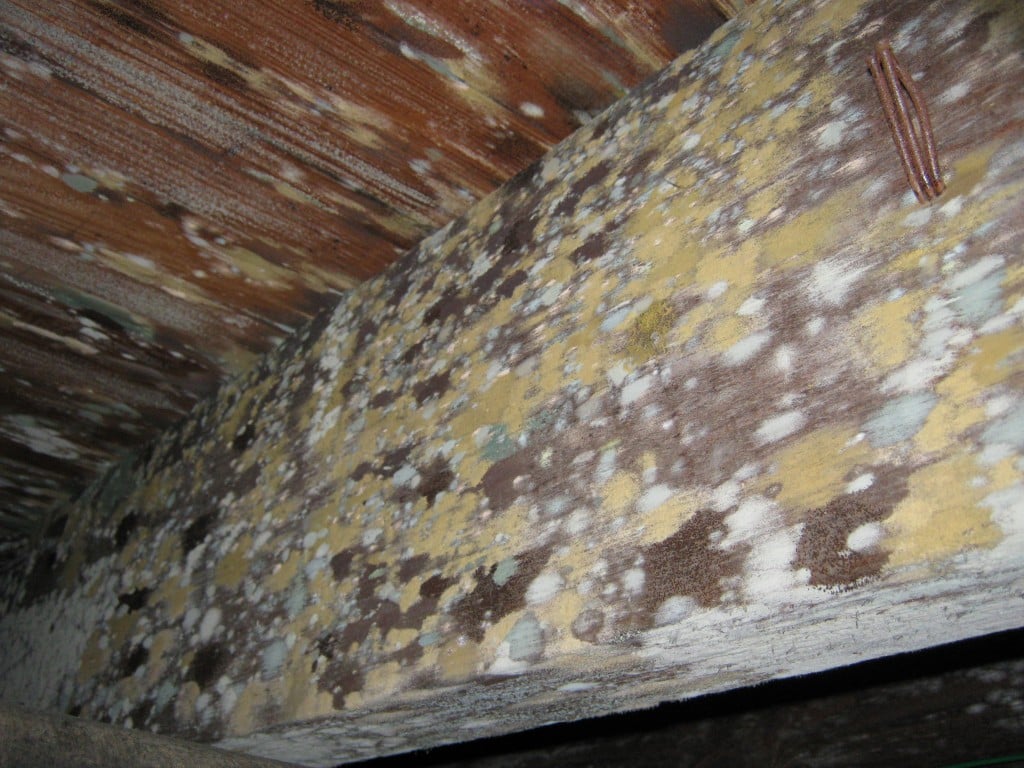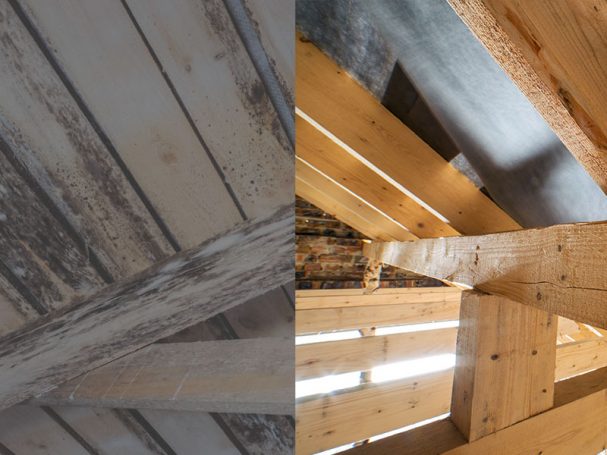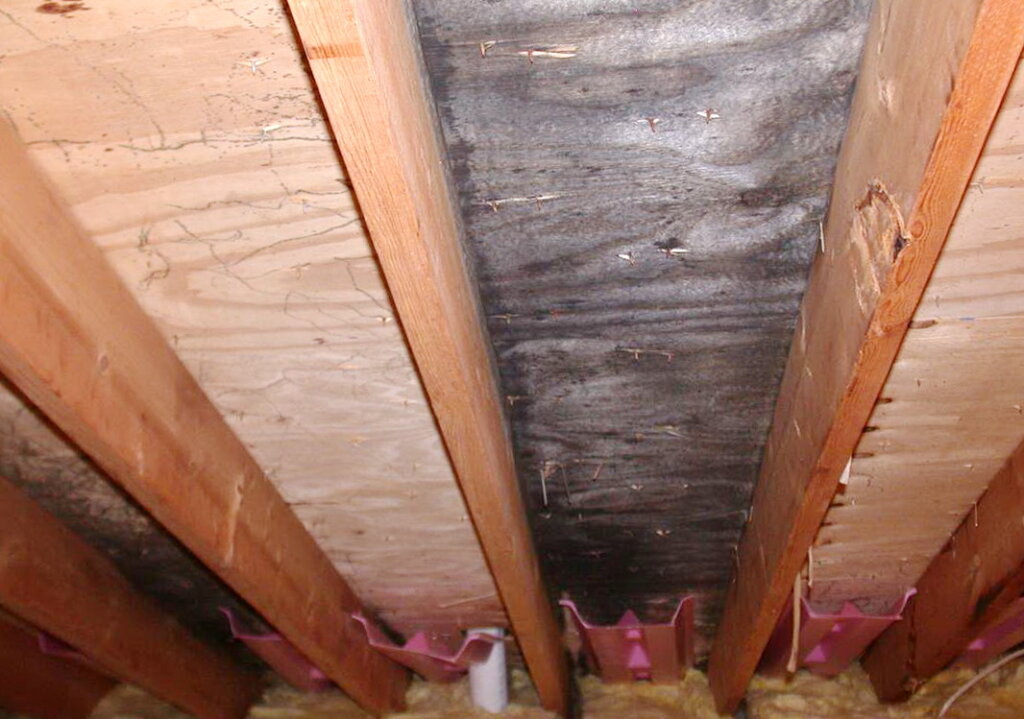If you’ve recently dealt with mold in your attic, you know the stress and inconvenience it can cause. But simply removing the mold isn’t enough – you want to make sure it doesn’t come back. So, how can you prevent mold from returning on your attic plywood? In this article, we’ll explore some effective tips and strategies to keep your attic mold-free and maintain a healthy living environment in your home. With these preventative measures, you’ll be able to bid farewell to mold and enjoy peace of mind.
Understanding Mold
Mold is a common issue that many homeowners face, and it can have detrimental effects on both your health and the structural integrity of your home. In order to effectively prevent mold from returning on attic plywood after removal, it is crucial to understand the causes of mold, its effects, and the common types of mold that you may encounter.
Causes of Mold
Mold thrives in environments that are damp, dark, and have poor ventilation. Some common causes of mold growth include high humidity levels, excessive moisture from leaks or water intrusion, insufficient insulation, and inadequate ventilation. It is important to address these underlying issues in order to prevent mold from recurring.
Effects of Mold
The presence of mold in your home can have various negative effects on your health. Mold spores can trigger allergic reactions, such as sneezing, coughing, and eye irritation, especially for individuals with respiratory conditions or weakened immune systems. Prolonged exposure to mold can also lead to more serious health issues, including respiratory infections and even long-term lung damage. Additionally, mold can cause damage to the structure of your home, leading to costly repairs and decreased property value.
Common Mold Types
There are several common types of mold that you may encounter in your attic, including black mold (Stachybotrys chartarum), green mold (Aspergillus), and white mold (Penicillium). Each type of mold poses its own risks and requires specific removal techniques. It is important to identify the type of mold present in order to effectively address the issue and prevent its recurrence.
Mold Removal Process
Once you have successfully removed mold from your attic plywood, it is crucial to follow a comprehensive and thorough mold removal process to prevent its return. This process involves several steps, including assessment and inspection, containment and safety measures, mold removal techniques, cleaning and disinfection, and a post-removal check.
Assessment and Inspection
Before beginning the mold removal process, it is important to assess the extent of the mold problem and inspect the affected areas. This will help determine the appropriate course of action and identify any underlying issues that may be contributing to mold growth.
Containment and Safety Measures
To prevent the spread of mold spores to unaffected areas of your home during the removal process, it is essential to establish containment measures. This may involve sealing off the affected area, using negative air pressure machines, and wearing personal protective equipment (PPE) to protect yourself from exposure to mold spores.
Mold Removal Techniques
Depending on the type and severity of the mold infestation, different removal techniques may be used, such as dry brushing, wet vacuuming, or HEPA vacuuming. It is important to consult with mold remediation specialists or professionals who can guide you in choosing the most effective technique for your specific situation.
Cleaning and Disinfection
After the mold has been physically removed, it is crucial to thoroughly clean and disinfect the affected areas to eliminate any remaining mold spores. This may involve using antimicrobial solutions or natural remedies to ensure a mold-free environment.
Post-Removal Check
Once the mold removal process is complete, it is important to conduct a post-removal check to ensure that all mold has been successfully eliminated. This may involve conducting air quality tests or visual inspections to verify the effectiveness of the removal process.

Identifying Underlying Issues
In order to prevent mold from returning on attic plywood, it is essential to address any underlying issues that may be contributing to mold growth. Common underlying issues include ventilation problems, insulation issues, roof leaks or water intrusion, and improper attic ventilation.
Ventilation Problems
Insufficient ventilation can trap moisture in your attic, creating a prime environment for mold growth. Addressing ventilation problems by improving air circulation can help prevent the recurrence of mold.
Insulation Issues
Inadequate insulation can lead to condensation and moisture buildup in your attic, providing the perfect conditions for mold growth. Ensuring proper insulation materials, maintaining adequate thickness, and sealing air leaks can help prevent mold from returning.
Roof Leaks or Water Intrusion
Roof leaks or water intrusion can introduce moisture into your attic, leading to mold growth on the plywood. Identifying and fixing any leaks or addressing water intrusion issues is crucial in preventing mold recurrence.
Improper Attic Ventilation
Improper attic ventilation can trap moisture and prevent proper airflow, creating an ideal environment for mold to thrive. Installing the right attic ventilation systems, such as gable vents, soffit vents, ridge vents, or attic fans, can help improve airflow and prevent mold growth.
Addressing Ventilation Problems
In order to effectively prevent mold from returning on attic plywood, it is important to address any ventilation problems that may be present in your attic. There are several methods you can employ to improve ventilation and reduce moisture levels.
Natural Ventilation
Using natural ventilation methods, such as opening windows, installing vents, or utilizing skylights, can help improve airflow in your attic. This allows for the removal of moisture and reduces the likelihood of mold growth.
Mechanical Ventilation
In cases where natural ventilation is insufficient, implementing mechanical ventilation systems, such as exhaust fans or attic ventilators, can help remove excess moisture and maintain optimal airflow in your attic.
Soffit Vent Installation
Soffit vents are an effective way to increase ventilation in your attic. Installing soffit vents along the eaves of your roof allows cool air to enter, pushing hot air and moisture out of the attic space.
Ridge Vent Installation
Ridge vents are installed along the ridge of your roof, allowing warm air to escape and promoting better airflow in your attic. This helps to reduce moisture levels and prevent mold growth.
Attic Fan Installation
Attic fans can help remove hot air and moisture from your attic, improving overall ventilation. They can be installed in conjunction with other ventilation methods for maximum effectiveness.

Improving Insulation
Proper insulation is crucial in preventing mold growth on attic plywood. In addition to addressing ventilation issues, it is important to ensure that your attic has adequate insulation.
Proper Insulation Materials
Choosing the right insulation materials, such as fiberglass, cellulose, or spray foam insulation, is essential in creating a barrier against moisture and preventing mold growth.
Maintaining Adequate Thickness
Insulation should be installed at the recommended thickness to provide optimal protection against moisture. Regularly checking and adding insulation as needed can help maintain a consistent barrier.
Sealing Air Leaks
Air leaks can compromise the effectiveness of insulation and allow moisture to enter your attic. Sealing any gaps, cracks, or openings can help prevent moisture intrusion and subsequent mold growth.
Professional Insulation Evaluation
If you are unsure about the condition or effectiveness of your attic insulation, consulting with professionals for an insulation evaluation can provide valuable insights and recommendations for improvement.
Repairing Roof Leaks
Roof leaks are a common cause of moisture intrusion in attics, which can lead to mold growth on the plywood. To prevent mold from returning, it is crucial to promptly locate and fix any roof leaks.
Locating and Fixing Leaks
Thoroughly inspect your roof for any signs of leaks, such as water stains, mold growth, or damaged shingles. Once located, repair the leaks immediately to prevent further water intrusion.
Replacing Damaged Roofing Materials
If your roof has damaged or deteriorated roofing materials, such as shingles or flashing, it is important to replace them to ensure a watertight seal and prevent future leaks.
Gutter Maintenance
Clogged or damaged gutters can lead to water overflow, which can seep into your attic and promote mold growth. Regularly clean and maintain your gutters to prevent water from pooling near your roof.

Ensuring Proper Attic Ventilation
Proper attic ventilation is vital in preventing mold growth on attic plywood. By implementing the right ventilation systems and regularly maintaining them, you can significantly reduce the risk of mold recurrence.
Installing Vents on Gable Ends
Gable vents are installed on the exterior walls of your attic, allowing air to enter and exit. Installing gable vents promotes better airflow and helps remove excess moisture from your attic.
Checking and Repairing Soffit Vents
Soffit vents are located on the underside of the roof overhang and are crucial in providing fresh air intake for your attic. Regularly inspect and repair any damaged or blocked soffit vents to ensure proper ventilation.
Evaluating Roof Shape and Design
The shape and design of your roof can impact attic ventilation. Evaluating the roof’s design and considering modifications, such as adding dormer vents or changing the pitch, can improve airflow and prevent mold growth.
Consulting with Professionals
If you are unsure about the best methods to ensure proper attic ventilation, consulting with professionals, such as roofing contractors or ventilation specialists, can provide expert guidance tailored to your specific needs.
Maintaining Optimal Humidity Levels
Controlling humidity levels in your home is essential in preventing mold growth. By implementing measures to reduce excess humidity and monitoring levels regularly, you can effectively prevent mold from returning on attic plywood.
Using Dehumidifiers
Dehumidifiers can help reduce excess moisture in your home, including your attic. Placing a dehumidifier in your attic or utilizing a whole-house dehumidifier can help maintain optimal humidity levels.
Monitoring Humidity with Hygrometers
Hygrometers are devices used to measure humidity levels in your home. Regularly monitoring humidity levels, especially in your attic, can help identify potential moisture issues before they lead to mold growth.
Avoiding Excessive Moisture Sources
Preventing excessive moisture from entering your attic is crucial in mold prevention. Avoid activities that generate excessive moisture, such as drying clothes indoors or improper venting of bathroom and kitchen exhaust fans.

Regular Inspections and Maintenance
Regular inspections and maintenance of your attic can help identify and address mold-promoting conditions before they escalate. By implementing scheduled inspections and promptly addressing issues, you can prevent mold from reoccurring.
Scheduled Inspections
Schedule regular inspections of your attic to identify any signs of water damage, leaks, or mold growth. Promptly address any issues to prevent further damage and mold recurrence.
Cleaning Gutters Regularly
Regularly cleaning and maintaining your gutters prevents water overflow and minimizes the risk of water intrusion into your attic. Remove debris to ensure proper water drainage away from your home.
Monitoring Attic Conditions
Regularly monitor the conditions in your attic, including temperature and humidity levels. Address any deviations from optimal conditions promptly to prevent mold growth.
Promptly Addressing Issues
If you notice any signs of mold growth, water damage, or other issues in your attic, address them promptly. Swift action can prevent the spread of mold and mitigate further damage.
Professional Assistance
In some cases, seeking professional assistance is necessary to effectively prevent mold from returning on attic plywood. Mold remediation specialists, HVAC maintenance services, and roofing professionals can provide expert guidance and services.
Consulting Mold Remediation Specialists
If you have a severe or recurring mold problem, consulting mold remediation specialists can provide professional assessment and removal services. Their expertise and specialized equipment can ensure thorough mold removal and prevent its return.
Considering HVAC Maintenance Services
Your HVAC system plays a significant role in controlling humidity levels and providing proper ventilation. Regular HVAC maintenance, including cleaning air ducts and inspecting filters, can help prevent moisture buildup and mold growth.
Hiring Roofing Professionals
When addressing roof leaks or ventilation issues, hiring roofing professionals ensures that repairs or installations are done correctly. Roofing professionals can identify underlying issues and provide long-term solutions to prevent mold recurrence.
By understanding mold causes, its effects, and the common types, you can take proactive steps to prevent mold from returning on attic plywood. Implementing a comprehensive mold removal process, addressing underlying issues, improving ventilation and insulation, and maintaining optimal humidity levels will help create a mold-free environment in your attic. Regular inspections, prompt maintenance, and seeking professional assistance when needed will further enhance your mold prevention efforts. Remember, prevention is key in avoiding the harmful effects of mold on your health and home.
